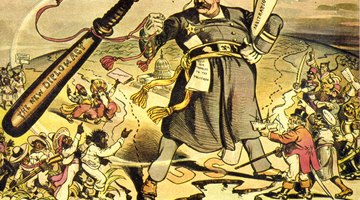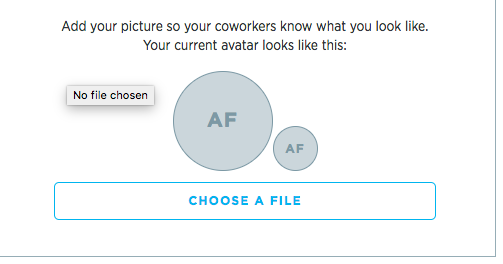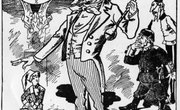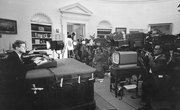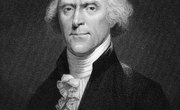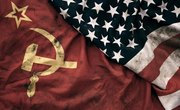The Roosevelt Corollary was created by Theodore Roosevelt as an appendage to the Monroe Doctrine. Although it was conceived as an addendum to the doctrine, the language and permission that the corollary allowed the United States turned the actual goal of the Monroe Doctrine on its head in many ways, allowing the U.S. to exercise its influence in Latin America and the Caribbean.
Tip
The Roosevelt Corollary allowed the U.S. to involve itself in the affairs of any country in the Western Hemisphere whose political or economic unrest could potentially cause problems for the U.S.
The Monroe Doctrine
The Monroe Doctrine, which had been signed into law during the administration of James Monroe in 1823, was a document that vehemently opposed any further European colonialism in South and North America. Monroe announced the formation of the doctrine during his seventh state of the union.
At this time, many South and North American nations were beginning to gain their independence from the imperial European powers that had ruled them from afar, and the kind of unrest that this revolt and rebellion was producing caused European powers to send their own forces to the continent in an effort to quell revolution and reinstate their own power. The Monroe administration, seeing that this kind of issue was to become a regular thing if colonialism persisted, decided to create the doctrine as a protection against this sort of unrest.
The Monroe Doctrine stated that any European nation that attempted to seize control of any Central or North American nation would be viewed as having made a threat against the U.S. The doctrine also stipulated that the U.S. would not meddle or interfere in any way with existing and stable countries that were controlled by European powers. This allowed the European colonies that were already in existence to continue under European rule without incident while also preventing the possibility of European interference in any of the nations that were in the process of gaining their independence. Doing so would result in a conflict with the heavily armed and very prosperous U.S.
The Roosevelt Corollary
In the very early years of the 20th century, President Roosevelt was concerned about the possibility of an armed conflict between Venezuela and its European creditors. The concern that the conflict could escalate to a point that necessitated European armed invasion was disquieting to the president.
For this reason, he created an addendum to the Monroe Doctrine known as the Roosevelt Corollary. The Roosevelt Corollary acknowledged that the Monroe Doctrine stated that the U.S. would not meddle in the affairs of European nations that had existing colonies in North or South America. However, it did stipulate that in the case of unrest caused by one of the nations in the Western Hemisphere, the U.S. was justified in using force. In other words, because the U.S. felt stable enough to be the policeman of its respective continent, the Roosevelt Corollary existed to give it the opportunity to enforce laws in Europe's absence rather than allowing foreign nations to come to the shores of North and Central America and deal with the problems themselves.
It's easy to wonder about the meaning of the Roosevelt Corollary. There is a surface meaning and a somehow hidden meaning, but regardless of your perspective, there is no denying that the consequences of this corollary are significant and history-making. While on the surface the corollary simply allows the U.S. to act in lieu of European powers when facing problems or uprisings in the North and Central American countries they had colonized, in actuality the corollary gave the U.S. free rein to intervene in the government of any nation in North America, Central America or the Caribbean in the guise of protecting peace and managing European interests. This corollary was an example of what would come to be known as Roosevelt's "big stick" foreign policy.
"Big Stick" Policy
What factors spurred American imperialism? President Roosevelt felt that U.S. power could potentially be dangerous in the wrong hands but the most important thing the nation could do was do its best to try and retain control of the North American continent and the Western Hemisphere. In Roosevelt's view, what was good for the nations of North and Central America and the Caribbean were good for the U.S. This, of course, meant an absence of interference from foreign powers.
The message that the U.S. had sent prior to 1900 was strong and unmistakable: There was to be no more colonization of the Western Hemisphere by any foreign powers. Roosevelt felt that the U.S., as the most prosperous nation in the hemisphere, had both the right and the responsibility to police and manage the area. This was his "big stick" policy, the name of which comes from a quote of his in which he said, "I have always been fond of the West African proverb: 'Speak softly and carry a big stick; you will go far.'"
The meaning of this expression is the suggestion that you can be diplomatic in your negotiations with people, but your diplomacy will be much more effective if the people with whom you are negotiating can see that there is the dormant possibility of tremendous force should they not comply with you. By framing the Roosevelt Corollary the way that he did, Roosevelt was able to reassure the European nations that their interests would be protected by a powerful force while also subtly hinting with no out and out aggression that the U.S. would not accept any further interference in the area from foreign powers.
What Are Some Examples of "Big Stick" Policy?
Taken at face value, the Roosevelt Corollary is about European interference, but seen through the lens of American imperialism, it is clearly a loophole that allowed the U.S. to interfere and potentially have interest in the very nations that it forbid European powers from attempting to colonize.
Roosevelt's support for the Panama Canal a few years before the corollary was signed is an example of such an action. For many years, the idea of a canal connecting the Atlantic and Pacific Oceans had been alluring to both Europeans and the powers in the U.S. However, any attempts at creating such a canal had failed. Roosevelt, however, was determined to succeed, and he did so by wielding his "big stick." He had offered money to Panama, which at that time was part of Columbia. The Columbians were furious, saying that the price was too low and there would be no canal. Roosevelt's response was to tell the press that he would support any revolution the people of Panama wanted to wage against Columbia in the effort to establish their independence.
Roosevelt sent warships down to Columbia to practice maneuvers as the revolution took place. When Panama was victorious, Roosevelt gave the fledgling nation the money that had been too low for Columbia and thereby was able to build the Panama Canal.
Roosevelt Corollary in Action
The Roosevelt Corollary allowed the U.S. to make itself involved in the business of any country in North or Central America and the Caribbean at any time it deemed necessary. Once the corollary was made official, Roosevelt wasted no time in acting on it. He used the corollary as a justification for establishing "protectorate" relationships over Cuba and Panama and involving the U.S. in the management of the Dominican Republic's revenues.
Related Articles
References
Writer Bio
Ashley Friedman is a freelance writer with experience writing about education for a variety of organizations and educational institutions as well as online media sites. She has written for Pearson Education, The University of Miami, The New York City Teaching Fellows, New Visions for Public Schools, and a number of independent secondary schools. She lives in Los Angeles.

